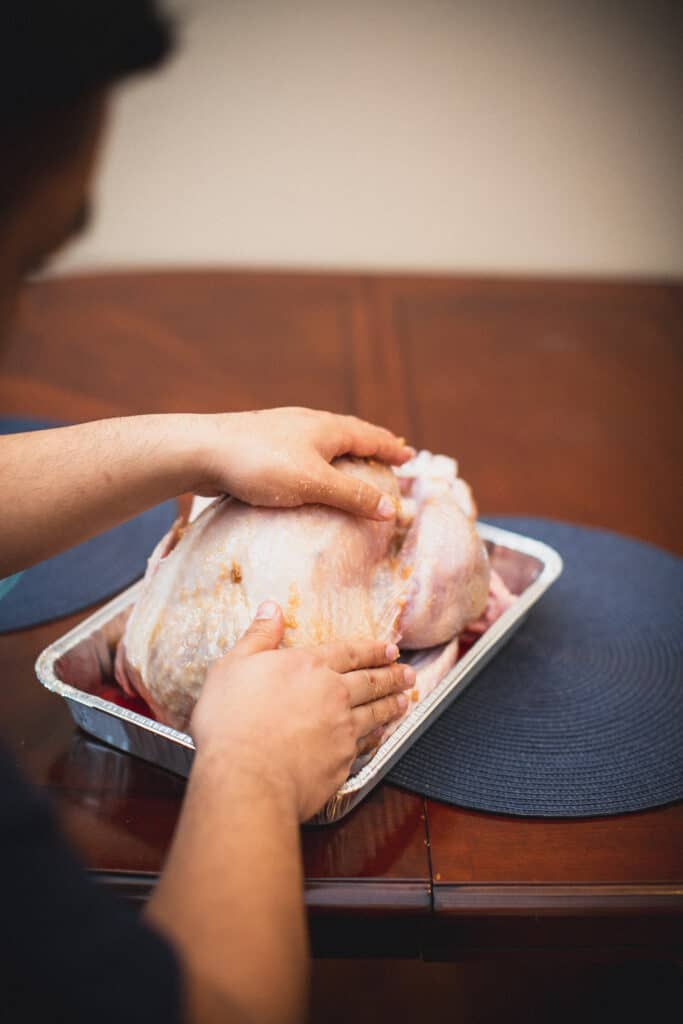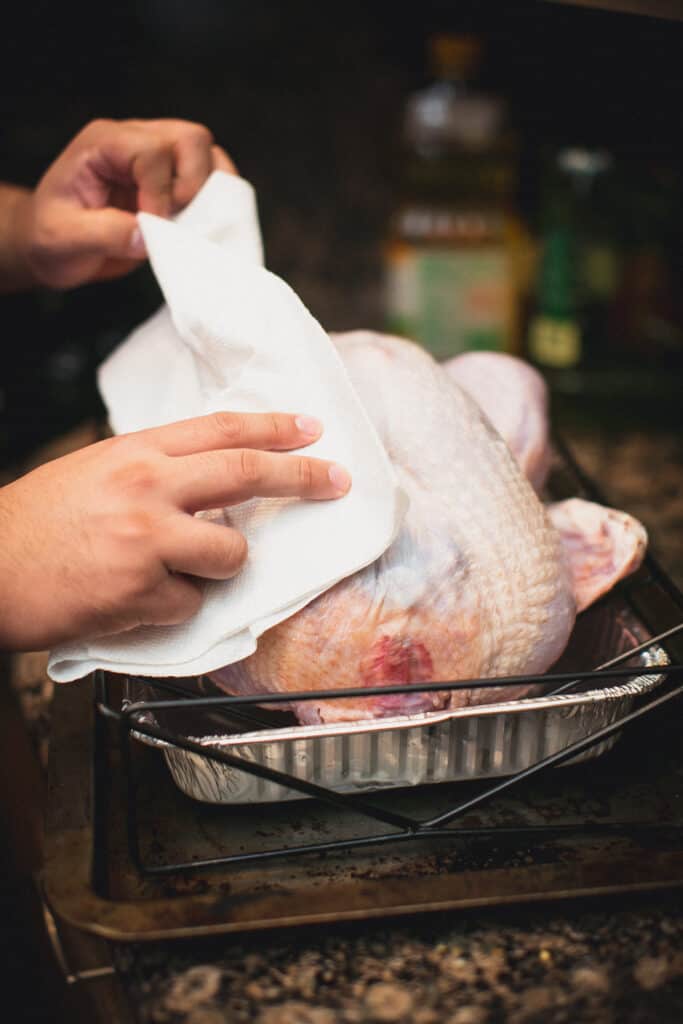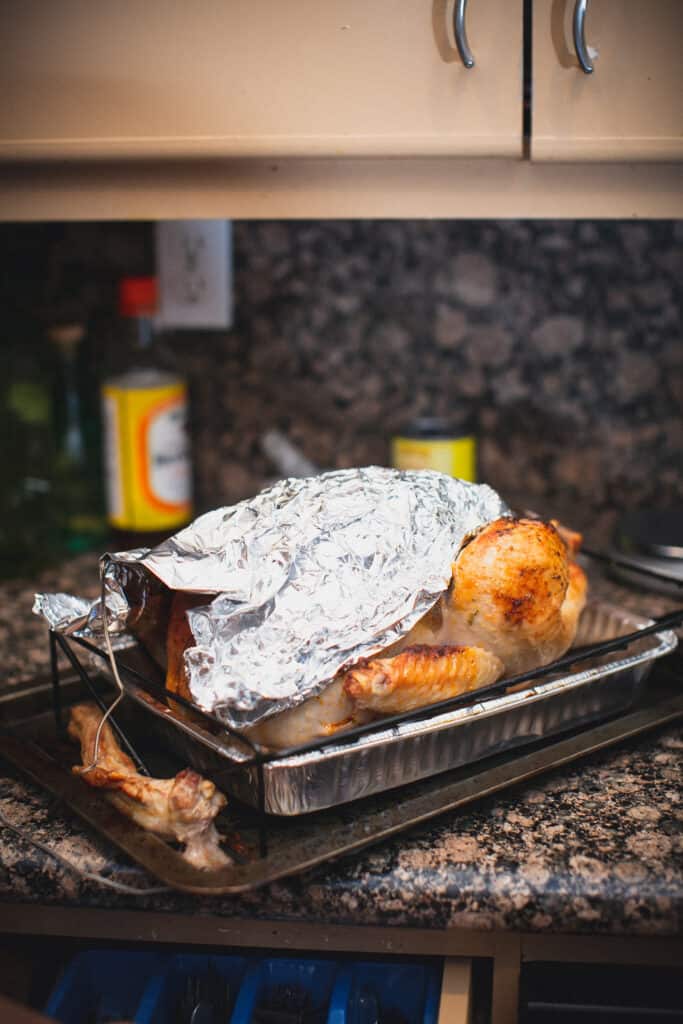As an Amazon Associate we earn from qualifying purchases.
Turkeys are inherently difficult things to cook because they are big, often frozen, very lean, and have bones. Plus, I don’t eat them very often and so I rarely get practice cooking them. Just ask yourself, how many times have you made chicken breast compared to how many times you have baked a turkey?
So don’t worry, if the idea of cooking a turkey stresses you out, you are not alone. The good news is, I am here to help!
Quick Navigation
How to Pick a Turkey
One of the most daunting tasks with Thanksgiving is picking the perfect bird. There are so many labels, brands, and types to consider, so where do you start? In this section, I’ll go over the main points for picking a turkey. First things first, I need to know how big a turkey I need and when to buy it.

Turkey Breeds and Options Explained
Go to the store and read the labels on the turkeys and there will be a bunch of words and names on them. Some of the important ones to pay attention to are:
| Term | Meaning | Recommended? |
Self Basting X% Sodium Solution Pre Brined | Turkey was injected with sodium, fat, and liquid solution. | Avoid, I want to control what is in my turkey, and this can be done to mask damaging freezing effects |
| Free Range / Cage Free | Turkey was allowed to roam around, and this develops muscles and results in more turkey flavor in the turkey. | Yes, if the budget allows. |
| Pastured | Turkey lived outside and ate natural things. This is the better version of free range. | Yes, if the budget allows. |
| Natural | No added chemicals to the meat. This does not mean no antibiotics when the turkey was alive. | Yes, if the budget allows. |
| Organic | Natural and no funny stuff while the turkey was alive. This is better than just natural. | Yes, if the budget allows. |
| Kosher | Prepared in line with Jewish dietary restrictions. Salted and drained. | Recommended if you have dietary restrictions. Flavor is also more concentrated, so nice to try if you have the opportunity. |
| Heritage Turkey | This is the heirloom tomato of turkeys. They are the original breeds found in the US. | Highly recommended, but will have less breast meat and a slightly gamier flavor. |
| Hen | Female turkey, killed earlier, and generally smaller. | Should affect outcome |
| Tom | Male turkey, killed later, generally bigger than 14 pounds. Potentially more muscle development in dark meat. | Should affect outcome |
How Many Pounds of Turkey Do You Need Per Person?
Traditionally, you should plan for about 1 pound of turkey per person. If your family loves turkey and wants lots of leftovers, you can go up to 1.5 pounds per person. If you want to be safe, plan for 1.25 pounds per person.

Remember, a decent portion of the weight of the turkey is not meat. So, each person is not actually eating 1-1.5 pounds of turkey. That weight on the bag is some parts juice and fat that you will lose to the pan, connective tissue and cartilage, innards, and of course, bones.
Do the calculation for how much turkey you need and write it down – you will need it for the next few sections I cover. If you don’t want to do the math, look at my helpful chart below to determine the proper size turkey to get:
| People | Light eaters, each having 1 pound (lbs) | Average eaters, each having 1.25 pounds (lbs) | Turkey lovers, each having 1.5 pounds (lbs) |
| 4 | 4 | 5 | 6 |
| 5 | 5 | 6.25 | 7.5 |
| 6 | 6 | 7.5 | 9 |
| 7 | 7 | 8.75 | 10.5 |
| 8 | 8 | 10 | 12 |
| 9 | 9 | 11.25 | 13.5 |
| 10 | 10 | 12.5 | 15 |
| 11 | 11 | 13.75 | 16.5 |
| 12 | 12 | 15 | 18 |
| 13 | 13 | 16.25 | 19.5 |
| 14 | 14 | 17.5 | 21 |
| 15 | 15 | 18.75 | 22.5 |
| 16 | 16 | 20 | 24 |
| 17 | 17 | 21.25 | 25.5 |
| 18 | 18 | 22.5 | 27 |
| 19 | 19 | 23.75 | 28.5 |
| 20 | 20 | 25 | 30 |
Important notes about the chart:
- If you are looking at consuming less than 10 pounds of turkey, finding a whole turkey will be difficult in these sizes. Your options are really a turkey breast or you can buy a small turkey and just have lots of leftovers.
- If you are looking at consuming more than 25 pounds of turkeys, finding a whole turkey will be difficult in these sizes. Additionally, these will be older birds. You may want to consider buying and cooking 2 smaller turkeys instead.
Is Fresh Turkey Better Than Frozen?
Objectively, a fresh turkey is better quality-wise. Any freezing can damage the cell walls of the meat, causing moisture loss. That said, freezing techniques are much better than they used to be, so this effect is decreasing.
All that said, frozen is undeniably easier to deal with because you control the timeline and there are many more frozen turkeys than fresh. I tend to consider getting fresh turkey a roll of the dice.

If your market doesn’t allow pre-purchasing fresh turkeys, it is a big gamble to think you will find one in the right size 3-4 days before Thanksgiving. With frozen, on the other hand, you can buy it a week plus in advance and take your time thawing it.
When Should I Start Thawing My Turkey?
Whether you plan on buying fresh or frozen turkey, I think it’s critical to know how long both would take you. Nothing is going to mess up your Thanksgiving like waiting until the day of and the market only has frozen birds left.
Conventionally, it takes 1 day for every 5 pounds of turkey to thaw (defrost). So, if you buy a 15 pound turkey, expect about 3 days for it to defrost in a 40°F fridge. Be sure to check your fridge temperature – if it’s 33°F your turkey isn’t going to defrost for a week or more.
If you get stuck with having to buy a frozen turkey the night before Thanksgiving, you can thaw it over 8 hours by putting it in cold water (and changing the water every 30 minutes).
Here’s a basic breakdown of how many days it takes to thaw a turkey based on its weight:
| Frozen Turkey Weight (lbs | Days to Thaw |
| 10 | 2 |
| 11 | 2.2 |
| 12 | 2.4 |
| 13 | 2.6 |
| 14 | 2.8 |
| 15 | 3 |
| 16 | 3.2 |
| 17 | 3.4 |
| 18 | 3.6 |
| 19 | 3.8 |
| 20 | 4 |
How Long Does it Take to Cook a Turkey?
In general, you are going to be looking at about 15 minutes per pound at 350°F to properly cook turkey. If you are preparing the turkey for a holiday, I’d recommend you budget for 20-25 minutes because you are doing other things too like preheating, resting, and carving.
Also, cooking a turkey is more complex than just popping it in the oven. You need to think through:
- How thick parts of the bird are
- Is it fully defrosted?
- Is it sitting in liquid?
- How even your oven heats food

All of these factors make differences in cook time which is why a thermometer is the only way to tell if your turkey is done.
What Kind of Thermometer Should I Use?
I believe you should have 2 thermometers at all times in your house.
- One is an oven thermometer which can stay in the meat and give you general timing.
- The other is an instant read thermapen which you can use during the last few minutes or for fast cooking things like steaks and grilled meats.
DO NOT by any means use the little popper that comes with your turkey! It is set to go off at 165°F (or higher) which will make it dry and stringy.
Where Do You Stick the Thermometer in a Turkey?
If you only have one thermometer, you want to put it in the white meat. Specifically, you want to put it into the breast meat at the thickest part. Push it in until you get close to the bone. Do not touch the bone – if you do, back the thermometer back out a quarter inch.
If you have 2 thermometers, you can put the second one in the thigh following the same procedure. Don’t have a thermometer? Go get one. You cannot and should not guess the temperature of a whole turkey!
What Temperature is Turkey Done at?
Turkey needs to come out at 150°F. At this temperature, it takes only 3.8 minutes to pasteurize your food.
Forget 165°F – this is a crazy number that makes very little sense for cooking! 165°F represents instant “kill mode” for bacteria as if you took the meat from 0 to 165 in a few seconds (which is obviously impossible).

Killing bacteria is a factor of both heat and time. Every second at 140°F is a second at 139°F and 138°F and 137°F so the sum effect of heat pasteurization is more like the integral of temperature over time (my fellow math nerds will appreciate that).
I also need to take carry-over into account. Carry-over is the continued cooking effect of the coolest parts of meat as the temperature gradient from outside to inside equalizes. For example, if your thermometer was reading 165°F in the center of the meat, the only way that happens is if the outside of the meat was hotter than 165°F.
Let’s say you pull the turkey out at 165°F – well, since the outside was hotter, that temperature needs to average out towards the middle, so you will actually get higher than 165°F by the time you cut it open.
Take it out at 150°F and let it rest, and you will have a juicier, more tender turkey.
How Long Should a Turkey Rest After Cooking?
You should let the turkey rest for a minimum of 20 minutes. If you can, rest it for a full 45 minutes. I rest cooked meat because that same carry-over temperature gradient also has a physical effect on the meat.
More heat means more pressure, so cutting that turkey open when a pressure gradient exists means more juice being pushed out of the meat. Let it rest and you will keep those juices in the bird.
